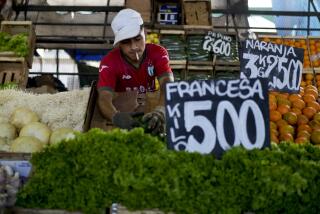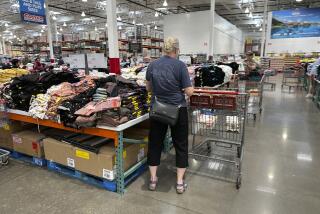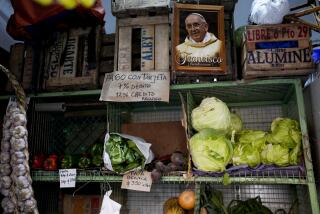Brazil’s Inflation Hits Record 15% for Month
- Share via
RIO DE JANEIRO — The highest rate of inflation ever reached in Brazil raised prices over 15% this month, according to official figures.
The price stampede reflected higher food prices, following severe drought damage to agriculture in southern Brazil, and a sharp increase in issuance of paper money to cover public deficits last year.
The crop failure and the breakdown in spending controls have undermined two of the main political pledges of President Jose Sarney, who promised Brazilians cheaper food and lower inflation after he took office last March.
The announcement by the Brazilian Institute of Statistics of a 15.7% increase in the January consumer price index produced an unusual weekend meeting in Brasilia of Sarney’s economic advisers.
The highest previous monthly figure was a 14% price rise last August, when Sarney shook up his economic team and brought in Dilson Funaro, a Sao Paulo industrialist, as minister of finance.
Funaro has put primary emphasis on policies encouraging growth, which raised the output of goods and services more than 7% last year. During 1985, workers obtained higher wages, compared with inflation, for the first time since 1980.
Printing Paper Money
But the government has failed to achieve targets for reducing its public deficit. Price controls imposed on state companies, such as Petrobras and Electrobras, maintained gasoline and electricity prices below inflation. However, these controls led to reduced government revenue and higher deficits.
Sarney, the first civilian president to take office democratically in 21 years, has refused to fire any public workers. Instead of reducing civil service labor costs and current spending, the government has resorted to printing paper money to pay wages and bills. Last year, the government-owned Bank of Brazil issued 33 trillion cruzeiros (about $4.5 billion) in new paper money, compared to 8 trillion in 1984. The currency growth was double the rate of inflation.
Funaro held his weekend meeting in Brasilia with Minister of Planning Joao Sayad, Fernao Bracher, president of the Central Bank, and a dozen department chiefs to see how to get government spending under control. Last week, Sarney ordered an iron hand on budget enforcement this year.
Funaro has announced that the budget deficit this year will be held to 3.4% of gross national product. The deficit will be financed mainly by internal borrowing.
But heavy borrowing has kept domestic interest rates at close to 20% above the rate of inflation, and the government’s drain on capital markets is competing for scarce funds with private investors. Without sustained private investment, the government cannot reach its growth target this year of 6%.
New Distribution System
But the main immediate problem is to slow the inflation. Funaro said that, by March, the monthly rate will be back to “9 or 10%,” which is the pace at which Brazil’s inflation last year reached 233%.
The economic team is trying to set up something new in Brazil--an effective national distribution system to supply about $1 billion in imported rice, beans, wheat, corn and vegetable oil at controlled prices. These products are being imported to offset drought losses.
In December, food prices rose 18%. The government was caught without food reserves, and speculators took control of the market. Imports have not yet reached Brazil’s markets in an amount necessary to stabilize prices.
The international consequences of the drought extending northward from Rio Grande do Sul state to the southern part of Minas Gerais has already been felt in coffee prices, which have soared. Brazil, the world’s largest exporter, lost at least 45% of its coffee crop.
But there have also been severe losses in cotton, soybeans, corn and beans, with declines in production from 20% to 40% in the affected regions. These are critical food and fiber products for Brazil’s 135 million consumers.
More to Read
Sign up for Essential California
The most important California stories and recommendations in your inbox every morning.
You may occasionally receive promotional content from the Los Angeles Times.













